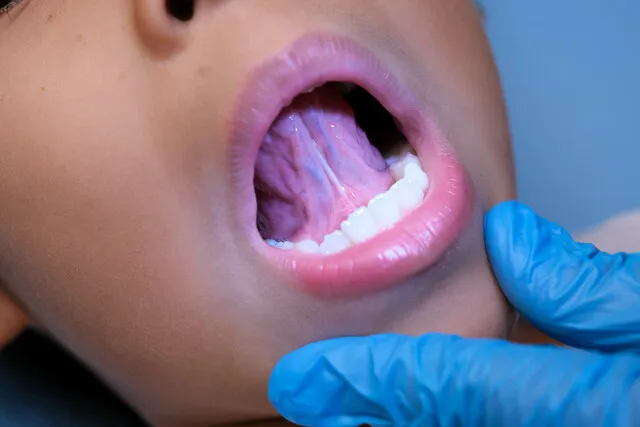A Guide to Infant Frenectomies and How to Find the Right Dentist for Your Little
Are you considering having infant frenectomies for your baby? If so, the process can be incredibly scary. Not only do you worry about the safety of your child, but there may also be a burden to make sure you find the right dentist who has both skill and experience in performing newborn procedures. But what is really involved in this process and how do you go about finding a reliable practitioner? In this guide, we’ll explore these topics in-depth while discussing some things to look out for along with helpful tips when it comes to deciding which dentist is best suited for your little one’s needs.
What is a Frenectomy and Why is it Needed for Infants
A frenectomy is a simple surgical procedure that involves the removal of the frenulum, a small piece of tissue that connects the tongue or lip to the mouth. While it may seem like a minor issue, many infants experience difficulty breastfeeding or speaking due to a frenulum that is too short or tight. This can lead to oral issues and even affect their overall development. In cases where a frenectomy is necessary, the procedure can be performed quickly and safely with little to no discomfort. It can provide infants with the freedom to move their tongue or lip more freely, allowing them to properly latch during feeding and develop their speech and language skills.
Find the Right Dentist for Your Procedure:
Choosing the right dentist for any procedure can be overwhelming, especially when it comes to complex treatments such as oral surgery or infant frenectomy. With so many options available, how do you know which one is right for you? In this guide, we’ll explore the most important factors to consider when selecting a dentist. By following these tips, you can find a qualified, experienced dentist who will ensure you receive the best possible care.
Experience and Qualifications:
The first thing you should look for when selecting a dentist is their experience and qualifications. Ensure that they have the necessary degrees and training to perform the procedure you need. Check if your dentist is a member of any professional associations such as the American Dental Association (ADA) or the International Congress of Oral Implantologists (ICOI). These credentials indicate that the dentist has demonstrated expertise in their field.
Reviews and Recommendations:
Don’t just rely on the dentist’s website to evaluate their expertise. Check for reviews and ratings on other sites such as Google, Yelp, or Health grades. You can also ask friends, family, or colleagues if they have any recommendations. Consider dentists with a high rating and positive reviews.
Procedures Offered and Technology Used:
Every dentist has their own area of expertise, and not all dentists offer the same procedures. Check to see if the dentist specializes in the procedure you need and if they use the latest technology and techniques. It’s important to choose a dentist who stays current with advancements in the dental industry.
Accessibility and Communication:
Another important factor to consider is the dentist’s accessibility and communication. Check if the dentist’s office is conveniently located for you and if they have office hours that fit your schedule. Also, consider the communication style of the dentist and their staff. Do they listen to your concerns and answer your questions clearly? Do you feel comfortable asking them questions?
Cost and Insurance Coverage:
Finally, consider the cost of the procedure and your insurance coverage. Make sure to get a cost estimate upfront, ensuring that there are no surprises later on. If you have insurance coverage, check if the dentist accepts your plan. Consider a dentist with flexible payment options, such as payment plans or credit options.

Tongue Tie
Benefits of an Infant Frenectomy
Infant frenectomy, the release of a baby’s tongue-tie, has become increasingly popular among parents and healthcare providers because of the range of benefits it offers. Tongue-tie is a condition frequently found in newborns and infants, where the frenulum – the strip of tissue that tethers the tongue to the floor of the mouth – is improperly developed and impedes the baby’s feeding. A frenectomy is a straightforward surgical procedure that frees the tongue’s mobility and promotes better feeding and speech development.
Moreover, a frenectomy can address not only difficult feeding but also the pain or unease a baby may experience. Infants with a tongue-tie may find it hard to manage their oral hygiene once they start teething and later in life may be more vulnerable to dental complications. National Institutes of Health reports showed that 5-10% of newborns experience tongue-tie, and up to 50% of infants that experience feeding challenges have tongue-tie. However, medical professionals continue to meet reluctance from some pediatricians, hospital administrators, and even parents to recommend frenectomies, leading to unnecessary prolonging of infant suffering and disruption to the quality of life for both babies and their parents.
Therefore, it is important to understand that a frenectomy greatly improves the chances of normalizing an afflicted infant’s oral functionality, thus allowing for optimum development and preventing complications. In addition, frenectomy is a fast and safe procedure that can significantly enhance the overall quality of life for babies and their families.
Common Types of Infant Frenectomies and Associated Costs
Infant frenectomies might seem like a foreign concept to many new parents, but the procedure is becoming more and more common due to its numerous benefits. The procedure, also known as frenotomy, involves cutting or using a laser to remove a small piece of tissue known as a frenulum that connects the tongue or upper lip to the bottom of the mouth.
Based on the location of the frenulum, there are two main types of frenectomy surgeries: the lingual frenectomy and the labial frenectomy. The lingual frenectomy involves removing the tissue under the tongue while the labial frenectomy involves removing the tissue above the upper lip. Both procedures are fairly quick and performed under local anesthesia, with the entire process taking approximately 15 to 30 minutes from start to finish.
One of the primary benefits of infant frenectomies is improved feeding and swallowing. The frenulum plays a significant role in the tongue’s mobility, and if it’s too tight or too short, it can limit the infant’s ability to suckle or swallow properly. By removing or loosening the frenulum, the baby can latch onto the nipple or bottle more easily, allowing for more efficient feeding.
Another benefit of the procedure is improved speech and pronunciation. In many cases, a tight or short frenulum can interfere with speech development, causing young children to struggle with enunciating certain sounds or letters. After the frenulum is removed, the tongue can move more freely, making it easier for them to form words and communicate effectively.
When it comes to costs, the price of a frenectomy depends on various factors, such as the location of the procedure, the type of frenectomy, and the surgeon’s fees. However, many insurance plans cover the procedure, and parents find that the benefits of the surgery far outweigh the costs.
Risks Associated with Infant Frenectomies
One of the most common risks associated with infant frenectomies is bleeding. While there is typically only minor bleeding after the procedure, there is the potential for excessive bleeding, particularly if the infant has a bleeding disorder or is taking medication that affects blood clotting.
Another risk associated with infant frenectomies is infection. The procedure involves breaking the skin barrier, which can increase the likelihood of infection if proper care is not taken. Careful post-operative instructions and follow-up care are essential to minimize this risk.
In addition to bleeding and infection, there is also a risk of damage to nearby nerves or tissue. This can cause pain, numbness, or altered sensation in the affected area. While rare, this risk should be considered before proceeding with the procedure.
Another potential complication is scarring or reattachment of the frenulum. While the goal of the surgery is to completely remove the frenulum, in some cases scar tissue can form and adhere the tongue or lip back to the gums, restoring the original problem.
It’s important for parents to carefully weigh the benefits and risks of the procedure with their healthcare provider before making a decision. While infant frenectomies can be effective in correcting feeding and speech issues, it’s important to fully understand the potential risks involved and make an informed decision.
How to Prepare for an Infant Frenectomy
If your child has been diagnosed with a tongue or lip tie, an infant frenectomy may be recommended. It can be a daunting experience for both parents and the baby, but with the right preparation, it can go smoothly. One important step is finding a trusted and experienced pediatric dentist or oral surgeon. They will be able to provide information about the procedure, as well as answer any questions and concerns. It is also important to have a plan for pain management after the procedure, such as using a soothing balm or medication as prescribed by the doctor. Lastly, try to stay calm and positive during the process, as babies can pick up on their parents’ emotions. Remember, the frenectomy is a simple and quick procedure that can greatly improve your child’s overall health and well-being.

Infant Frenectomy
Tips for Recovery After An Infant Frenectomy
In addition to keeping your baby comfortable and following the doctor’s post-operative care instructions, there are other steps you can take to ensure a smooth recovery after an infant frenectomy. For example, if your baby is experiencing discomfort or pain, you may want to consider using over-the-counter pain medication specifically designed for infants. Be sure to consult with your pediatrician before giving your baby any medication.
Another important factor to consider during a frenectomy recovery is feeding. Your baby may experience some difficulty with feeding, so it’s important to be gentle and patient during feeding times. You may want to try different feeding positions or techniques to help your baby feed comfortably. Additionally, if your baby is experiencing any bleeding or swelling in the area of the frenectomy, avoid feeding them solid foods or using a pacifier until their condition improves.
It’s also important to keep the area around the frenectomy clean and dry to prevent infection. Try to avoid exposing the area to moisture or saliva for the first few days after the procedure, and be sure to follow the doctor’s instructions for wound care. If you notice any signs of infection, such as redness, swelling, or discharge from the wound, contact your doctor immediately.
Finally, it’s important to stay positive and supportive during your baby’s recovery. Recovery from a frenectomy can be a challenging time for both you and your little one, but with plenty of love and patience, your baby will soon be back to their happy, healthy self!
Now that you know more about infant frenectomies, it is important that you make an informed decision about what is best for your child and their overall health. If you are considering choosing a dentist to perform the procedure, make sure to do your research and find someone who has extensive experience in performing these types of procedures on infants. It is also important to discuss any potential risks with them prior to the procedure. Lastly, if you have questions or concerns, don’t hesitate to ask your dentist as they can provide information on how to prepare for and recover from infant frenectomies. Whether you decide a frenectomy is right for your infant or not, understanding the details of this surgery will ensure that you make an informed decision and choose what’s best for your family.
Evergreen Pediatric Dentistry
https://www.google.com/maps?cid=14720788683151219551
12910 Totem Lake Blvd NE #103, Kirkland, WA 98034, United States
(425) 814-3196
https://evergreenkidsdentist.com/


